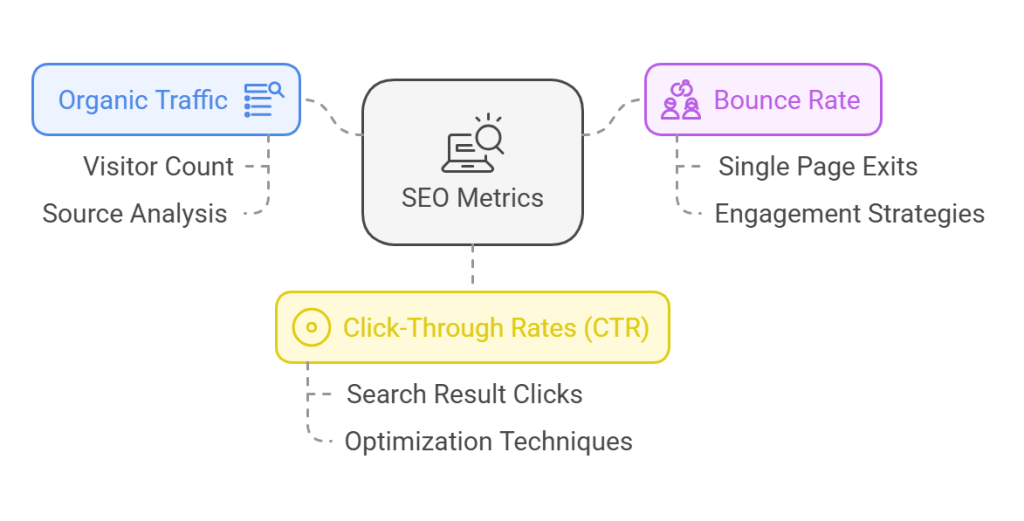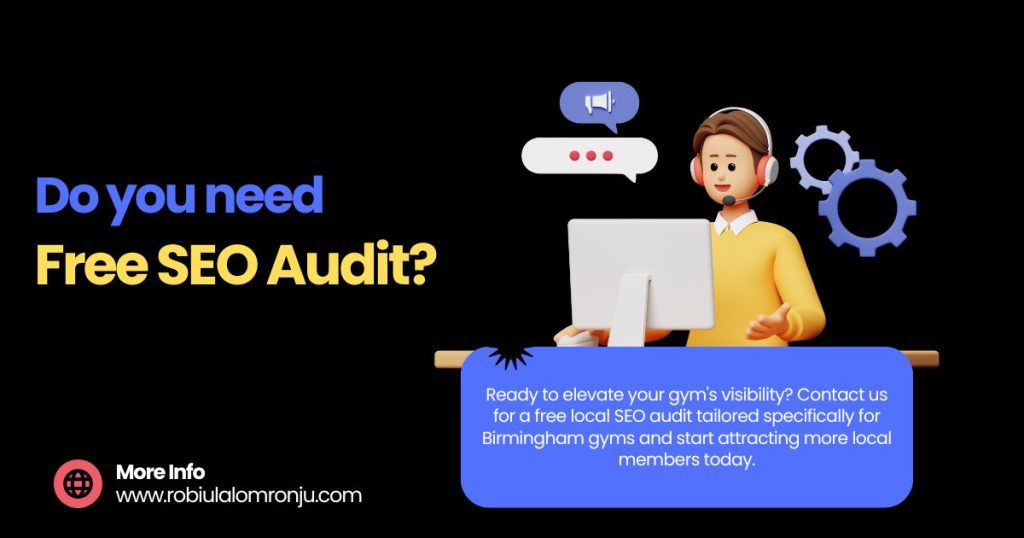
Introduction
What is SEO for Gyms?
SEO (Search Engine Optimization) is the process of optimizing a gym’s online presence to rank higher on search engines like Google, making it easier for potential members to find the gym. SEO includes both on-page and off-page optimization strategies that help gyms appear in relevant search results for terms related to fitness, health, and gym services.
Why SEO is Essential for Gyms:
- Increased Local Visibility: SEO helps increase visibility for local searches such as “gyms near me” or “personal trainers in [city],” which drives traffic from local inquiries. These local searches are critical for attracting walk-ins and new members who are nearby.
- Higher Credibility and Trust: Ranking on search engines organically establishes credibility and trust with potential members. Organic results are often viewed as more reliable than paid advertisements, making a higher ranking an important factor in gaining new members.
SEO Basics for Gyms: Setting the Foundation
What Does SEO Mean in Fitness?
SEO for gyms involves applying general SEO principles to the fitness industry, focusing on improving a gym’s online presence through targeted local searches and content creation. By using proper SEO techniques, gyms can reach a broader audience and improve their digital visibility to attract new members.
Core Benefits of SEO for Gyms:
- Boosts Memberships and Revenue: With increased online visibility, gyms can attract new clients and retain them longer, resulting in higher memberships and revenue. An optimized website ensures that your gym is visible to individuals actively searching for fitness-related services.
- Enhances Online Reputation: SEO helps gyms build an online reputation by encouraging positive reviews and producing high-quality content. This makes your gym stand out among competitors and strengthens the relationship with current and potential members.
Fitness Keywords That Work: To effectively target your audience, focus on relevant and specific keywords. Some examples include:
- “Gym in London”
- “24-hour Gym Near Me”
- “Personal Trainer Birmingham”
- “Yoga Classes in Romford”
Using long-tail keywords like “best personal training for beginners in [city]” can help target a more specific audience and lead to higher conversion rates, as these search terms are more specific and indicate a stronger intent to convert.
Step-by-Step Guide to Implementing SEO for a Gym Business
Deep Audit Your Website
Start by conducting a website audit using tools like Google Analytics and GTmetrix to measure your website’s performance. These tools help identify areas for improvement, such as page load speed and overall user experience. It’s essential that your website loads quickly—aim for under 3 seconds—as slow-loading pages can lead to higher bounce rates.
Additionally, ensure your website is mobile-friendly, as many users search for gyms on their smartphones. Check for broken links or outdated content and update them regularly to improve both user experience and SEO. Make sure your site structure is user-friendly, meaning easy navigation and clear calls to action, such as signing up for memberships or scheduling consultations.
Profitable Keyword Research
Effective keyword research is crucial for ensuring your gym ranks well on search engines. Use tools like Google Keyword Planner, Ahrefs, or Ubersuggest to identify the best local and service-specific keywords that potential members are searching for.
Focus on local search terms such as “fitness classes in [city]” or “gym memberships in [area]” to capture the attention of nearby prospects. Additionally, consider targeting long-tail keywords that specify services, like “personal trainer in [city]” or “24-hour gym near me.” These more specific keywords help attract users looking for precisely what your gym offers.
On-Page SEO Optimize
On-page SEO involves optimizing the content and structure of your website to rank better in search engine results.
- Page Titles & Meta Descriptions: Use your targeted keywords in your page titles and meta descriptions. For example, “Best Gym in London – Affordable Fitness Classes” is an effective title. Meta descriptions should briefly summarize what the page offers and include primary keywords.
- Headings & Image Alt Text: Use H1, H2, and H3 tags to structure your content and ensure that they contain relevant keywords. For instance, for a yoga class page, use headings like “Yoga Class at [Gym Name]” to optimize both for search engines and readability. Don’t forget to include alt text for images, describing them with keywords such as “Yoga Class at [Gym Name]” for better SEO.
Leverage Local SEO
Local SEO helps your gym show up in search results for people in your vicinity. Start by claiming and optimizing your Google Business Profile. Add your gym’s name, address, phone number (NAP), business hours, and photos to enhance your visibility. This is especially important for local searches such as “gyms near me.”
Additionally, build citations on trusted local directories like Yelp, Yellow Pages, and fitness-specific platforms. Encourage positive reviews from satisfied clients, as good reviews boost your gym’s reputation and help with ranking. Be sure to respond to all reviews, both positive and negative, professionally.
Focus on Content Marketing
Content marketing is a powerful tool for building authority and engaging potential gym members. Create valuable content that resonates with your audience. Some blog ideas include:
- “Top 10 Reasons to Join a Gym in London”
- “How to Stay Motivated for Your Gym Goals”
Also, consider creating tutorials, success stories, and engaging videos to attract visitors. For example, a video titled “How to Use Gym Equipment Properly” can help users feel more comfortable and informed when they visit your gym. Content like this establishes your gym as an authority and helps build trust with potential members.
Improve Technical SEO
Technical SEO ensures that your website is set up correctly for search engines to crawl and understand. Key actions include:
- Ensure HTTPS for security: Use HTTPS to encrypt data between your website and users, providing both security and a ranking boost in search results.
- Fix duplicate content: Duplicate content can confuse search engines and impact your rankings. Use tools like Copyscape or Siteliner to identify and fix duplicate content issues.
- Implement structured data: Add structured data (like LocalBusiness schema) to help search engines better understand your gym’s services and offerings. This will improve your visibility in search results and potentially earn you rich snippets or other special listings.
Monitoring and Improving SEO Performance
To ensure your SEO efforts are paying off, it’s crucial to track key metrics and make continuous improvements. Here’s how:
Track Key Metrics: Use tools like Google Search Console to monitor essential metrics such as:
- Organic Traffic: The number of visitors who come to your site via search engines.
- Bounce Rate: The percentage of visitors who leave your site after viewing only one page.
- Click-Through Rates (CTR): The percentage of users who click on your website’s link from search results.
Regularly Update Content: Keep your website fresh by updating blog posts, adding new services, or adjusting information on your homepage. This ensures that content remains relevant and valuable for both users and search engines.
Tweak Keywords Based on Trends and Performance: Keep an eye on keyword trends and adjust your content accordingly. If certain keywords aren’t driving enough traffic, or if new search trends arise, be ready to pivot and optimize your content for better results.
Avoid Common Gym SEO Mistakes
While implementing SEO for your gym, be mindful of the following common mistakes that can harm your rankings and reputation:
- Avoid Keyword Stuffing: Don’t overload your pages with irrelevant keywords. Keyword stuffing may lead to penalties from search engines and a poor user experience. Focus on natural, meaningful keyword usage instead.
- Neglecting Mobile Optimization: Many potential gym members will search for gyms on their smartphones. Ensure your website is mobile-friendly and offers a seamless experience for users on all devices. A mobile-optimized website is crucial for maintaining high rankings.
Advanced Strategies for Gym SEO
Take your gym’s SEO to the next level with these advanced strategies:
Collaborate for Backlinks: Partner with local influencers, bloggers, and other businesses to gain backlinks. Backlinks from reputable sources can boost your website’s authority and improve search engine rankings, helping your gym appear higher in search results.
Leverage Social Media: Use platforms like Facebook, Instagram, and YouTube to share engaging content such as blog posts, member success stories, and workout tips. Social media activity can drive traffic to your website and build a community around your gym.
Geo-Targeted Ads: Utilize Google Ads and Facebook Ads to run geo-targeted campaigns. This enables you to target local customers specifically, ensuring your ads reach people in your gym’s vicinity who are likely to convert into members.
Budgeting for SEO Success
When it comes to SEO for gyms, your budget will determine the approach you take. Here are two key options:
- DIY SEO: For smaller gyms on a tight budget, DIY SEO is a viable option. There are plenty of free tools and guides available to help you get started. For example, you can use Google Analytics, Google Search Console, and Yoast SEO (for WordPress). Although this option requires time and effort, it can yield results if you’re willing to put in the work.
- Hiring an SEO Agency: If you prefer a hands-off approach and have the budget for it, hiring an SEO agency can be highly beneficial. While it may be more expensive, an experienced agency brings expert knowledge to the table, handling all aspects of SEO, from website optimization to content creation and link building. This allows you to focus on running your gym while experts take care of improving your online visibility.
Real-Life Examples of SEO Success in Gyms
Here’s how SEO has helped gyms grow and succeed:
Case Study Example:
Gym Name: FitnessHub Gym (local gym example)
Results: After implementing targeted SEO strategies like local keyword optimization, content marketing, and local directory listings, FitnessHub Gym saw a 40% increase in website traffic and a 25% boost in new membership sign-ups in just six months. Their gym now ranks on the first page of Google for keywords like “best gym in [city]” and “personal trainer [city].
Testimonials:
Implementing SEO for our gym was a game-changer. We saw more walk-ins, more calls, and more online memberships. The process was easy to follow, and the results were worth every penny.” – Sarah, Owner of FitLife Gym.
Since we started focusing on SEO, we’ve had a steady increase in new clients. It’s been a great investment for our business!” – Mark, Owner of StrengthGym.
Conclusion
Implementing SEO for gyms is essential for long-term success. By focusing on local visibility, optimizing your website, and leveraging high-quality content, you can significantly boost your gym’s online presence. The benefits of SEO include increased traffic, higher credibility, and more memberships, all of which contribute to the growth of your business.
 Don’t let competitors outrank you—boost your gym’s visibility with SEO today! Whether DIY or with an expert, start now to grow your membership and stay ahead.
Don’t let competitors outrank you—boost your gym’s visibility with SEO today! Whether DIY or with an expert, start now to grow your membership and stay ahead.
Frequently Asked Questions (FAQ)
Why is SEO important for my gym business?
SEO helps increase your gym’s online visibility, attract local clients, and build trust, leading to more memberships and higher revenue.
How long does it take to see results from SEO?
SEO is a long-term strategy. Typically, you’ll start seeing noticeable results in 3-6 months, depending on your efforts and competition.
Do I need to hire an SEO agency or can I do it myself?
You can start with DIY SEO using free tools, but hiring an agency provides expert guidance and can speed up the process for optimal results.
What are the best local keywords for gym SEO?
Keywords like “gym in [city],” “personal training in [area],” and “24-hour gym near me” are great for attracting local clients searching for fitness services.
How do I measure my gym’s SEO performance?
Use tools like Google Search Console to track organic traffic, bounce rates, and rankings. Regular updates to content and keyword optimization will keep your gym ahead in search results


